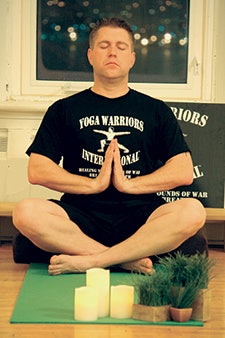Yoga certainly is not new to the military - whether it's used to cope with the effects of post-traumatic stress or as a supplement to a rigorous workout regimen. But establishing a successful yoga program requires some special care and consideration, as the military fosters unique challenges. And the whole process should start with the instructor.
 (Photo by Yoga Warriors International)
(Photo by Yoga Warriors International)Yoga certainly is not new to the military - whether it's used to cope with the effects of post-traumatic stress or as a supplement to a rigorous workout regimen. But establishing a successful yoga program requires some special care and consideration, as the military fosters unique challenges. And the whole process should start with the instructor.
"You want to look at their certification [and] if they're certified at least a 200-hour [minimum] and from a registered school through the national Yoga Alliance," says Lucy Cimini, founder of Yoga Warriors International, a nonprofit organization that trains yoga instructors to address PTSD and combat stress issues. "If it's for the military, then you want to see if they've got some experience in some kind of trauma-sensitive yoga or yoga therapy."
Robin Carnes agrees. She is co-founder of Warriors at Ease, an organization that trains yoga teachers to work in military and veteran communities. She has also worked for six years as a yoga and meditation teacher for people in an acute PTSD outpatient program at Walter Reed National Military Medical Center.
"You can hire a very skilled yoga teacher who knows how to teach yoga postures," she says. "But if they don't have the cultural sensitivity and the training and trauma sensitivity and the psychological aspects of working with the people who are showing up in your room, you are tying the hands behind the back of your program."
Sam Chase, a New York-based yoga instructor, who often conducts classes for members of the National Guard, encourages those operating a military fitness center to give a bit of pause when addressing a yoga program.
"I know that a lot of folks in the military are reluctant to self-identify in that way," he says. "So, I think there needs to be at least some tact and sensitivity in how those particular resources are presented."
For example, he suggests that offering workshops simply titled "Yoga for PTSD" probably wouldn't encourage attendance. But a staff member skillful in using yoga as a practice and who knows how to adapt to individuals can have a positive impact on the entire class.
Annie Okerlin, owner of Yogani Studios in Tampa, Fla. and president of the Exalted Warrior Foundation, which provides yoga instruction to wounded warriors, says it's important that a facility and its instructors understand that after 11 years of the country in a combat footing, most everyone attending classes at a military facility will have a heightened state of stress. But she says that yoga shouldn't just be reserved for someone possibly coping with combat-related stress issues. People at a military base who attend a yoga class also want a workout, and if the instructor understands the military culture, it's a way to connect directly with individual students.
"PT is such a huge part of the day to day for the military, so when I go on a base, I will do a strong physical practice," Okerlin says. "I'll also leave a good chunk of time at the end to get a long relaxation."
It's something Chase often identifies with when working with National Guard members. Unfortunately, preconceived notions about yoga often make it "off putting," he says. Okerlin and Carnes agree that the image of yoga might be a tough sell for members of the military. But it doesn't have to be that way.
"Another common myth about yoga is that it's a lifestyle ... you have to become a vegetarian or something, or a pacifist," Carnes says. But that's not the case. "If you want to consider it as a complement to or a part of your overall fitness or exercise program," she adds, "it can very well be that."
Chase deals with this issue often.
"I've noticed in my own work, when I present yoga to people in the military ... it's a tool for teaching your body and your breath and your brain to help each other out when things get challenging," he says. "Suddenly they see it as a tool that they can use to help them do all the things that are asked of them by virtue of their service."
That's only the beginning, however. A yoga program is more than simply bringing on a qualified instructor. It's about coordinating schedules and classes to foster the best attendance. Perhaps even more important, it can serve as a gateway to connect with some of the most vigorous workout programs, from CrossFit to P90X. It's a matter of assembling the right package, following through and understanding that yoga can be part of the whole and boost performance in other disciplines.
Stay tuned to Military Yoga Part 2 for ways to boost yoga class attendance, while also whetting the appetite of even the most dedicated strength and endurance-training junkies.




































